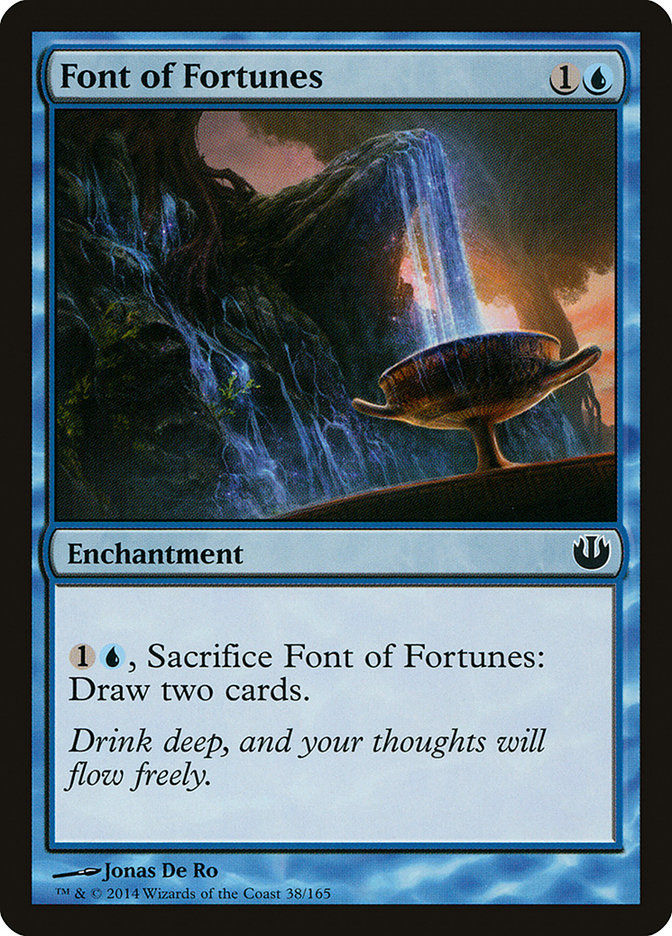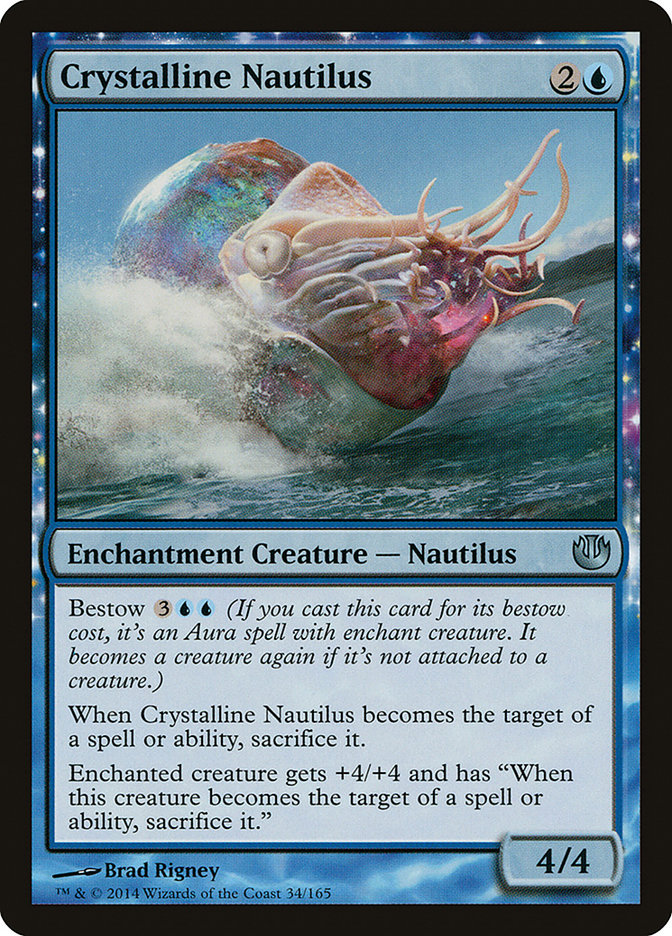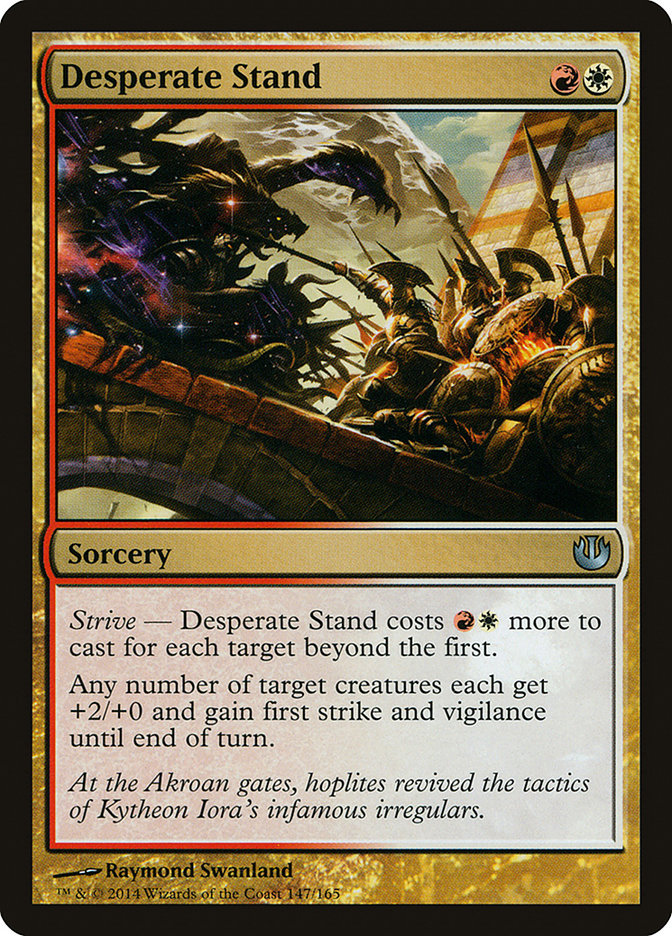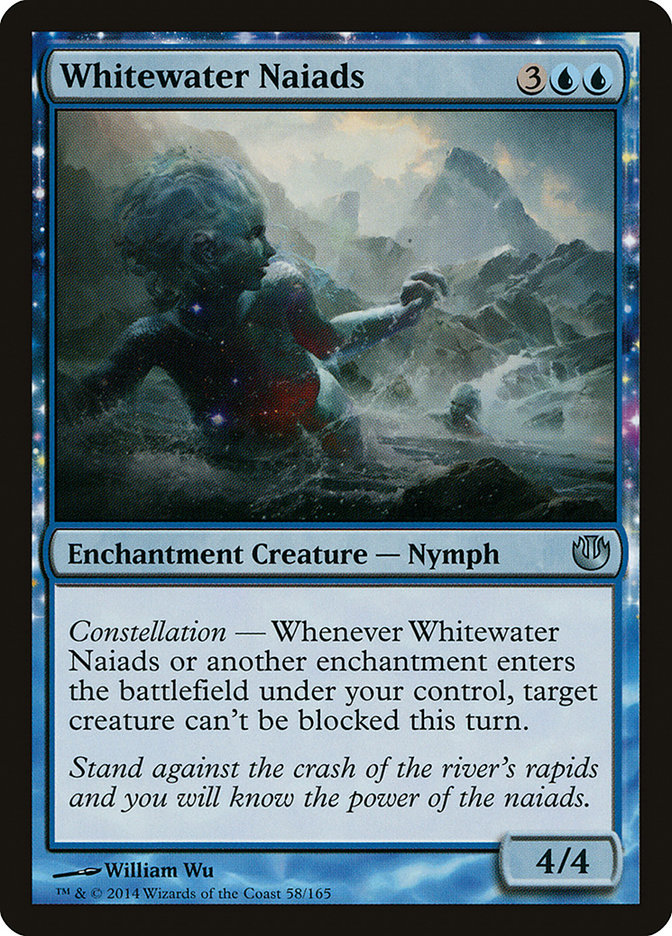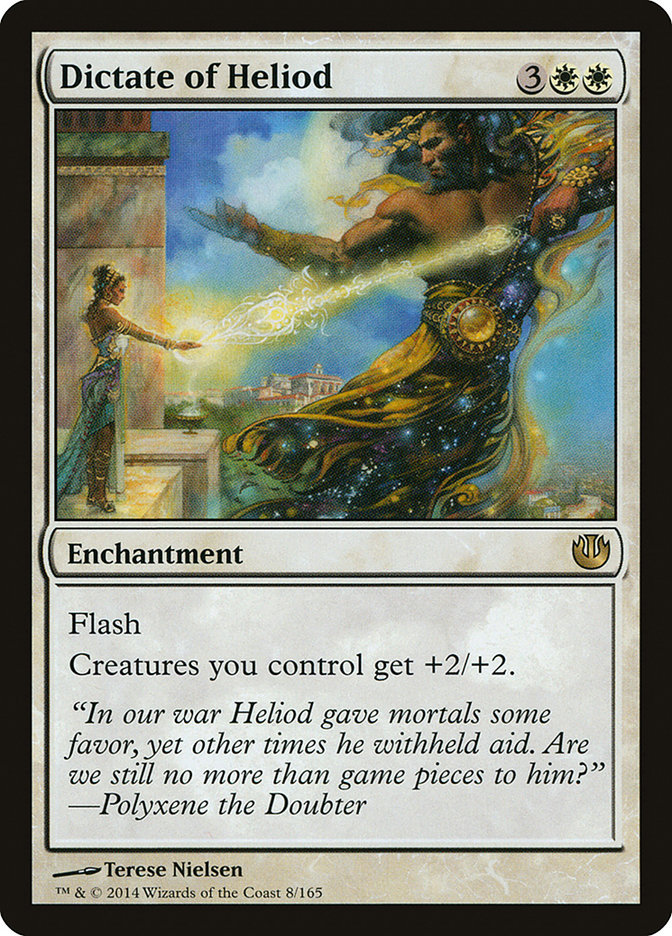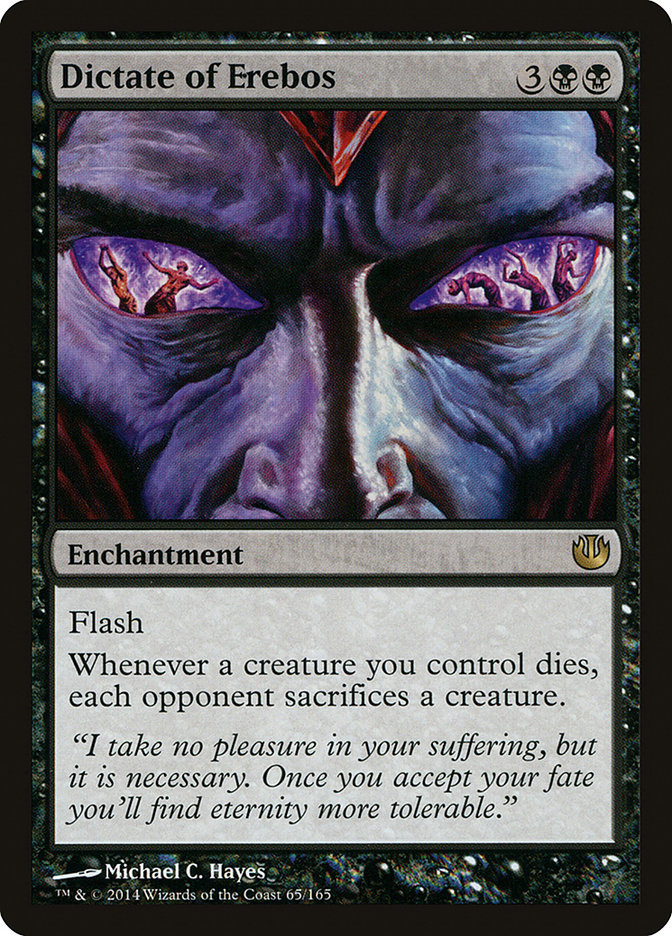On April 5th there was a big local Standard tournament in town called the SLAM, which featured a $500 first prize, a Top 8 Modern Masters draft, and the title of Champion of the South (formerly known as King but retitled to avoid gender bias). I had other plans though—my girlfriend Hillary and I decided to be the only Louisiana players to show up to a “secret” Theros/Born of the Gods Limited Pro Tour Qualifier in Tupelo, Mississippi. Given that a lot of my peers would be distracted by the cash tournament, the SCG Open Series in Milwaukee, or Grand Prix Phoenix, I felt like the tournament would provide a solid opportunity for me to qualify for the Pro Tour.
Fortunately my sealed pool was light in certain colors and deep in others, leading to an easy focus when building my deck. Below is the list that I settled on. Notable playables in the sideboard were Excoriate, Omenspeaker, and the black package of Ashiok, Nightmare Weaver; Unknown Shores; and possibly Shipwreck Singer.
Creatures (15)
Spells (25)

I wholeheartedly believe that everyone—and I mean everyone—builds their sealed pool wrong, and I am no exception. Twenty minutes simply isn’t enough time to fully wrap your head around all of the possible builds within the 84 cards you receive, and Theros/Born of the Gods Sealed is a very complicated format. The best that you can do is build your deck as well as possible in the allotted time, which often takes the full amount of time. I believe that if you want to succeed you should reevaluate your sealed pool after their first round.
Another good ten or twenty minutes looking at your 22nd and 23rd cards and taking another look at your other playable colors will open up opportunities for sideboarding in the future. Oftentimes colors will be so close in playability that sideboard cards like Dark Betrayal or Glare of Heresy will push the power level of their color high enough that it’s right to make the switch. The key is not being too lazy or embarrassed to sideboard twenty cards or to ask the judge to bring you some basic lands.
In this case my initial deckbuilding mistake was not resigning Archetype of Imagination to the sideboard. It is a strong card, but its biggest strength in my deck was to remove flying from opposing creatures. Archetype of Imagination is supposed to be a high-impact finisher, and that’s not something that my deck was lacking. Most games ended on the back of Sudden Storm or Sea God’s Revenge. Bestow creatures also provide great utility as late game plays. I figured out that I should’ve started Omenspeaker for the following reasons:
- In Sealed Deck I like to draw first. To do so without getting run over, you need a certain number of two-drops, and Omenspeaker adds to this count and softens the early beats.
- Omenspeaker allows for more keepable hands. I thought my mana was good and not too strict. Still, Magic seems to punish your mana base in any way possible. Having a hand with two Islands and an Omenspeaker is just fine while Archetype of Imagination isn’t.
- Sea God’s Revenge was also hanging in my six-drop curve, and two copies of Sudden Storm were close below. Between those the deck operated under a very tempo-esque nature and didn’t usually need a card like Archetype of Imagination to breakthrough the board.
I had Ashiok, Nightmare Weaver in my pool as well. In Theros/Born of the Gods Limited I prefer to stick to two colors whenever possible, and my blue and white were certainly strong enough to not need to extend into a third for more power. Shipwreck Siren would’ve come along as well with the black sources only being two Swamps and an Unknown Shores. I basically never splash for a single card of a color since I feel that three sources is the minimum to reliably cast a spell of a color and that having only one strong card of a splash color won’t outweigh the costs of having a less consistent mana base.
I choose to draw in most of my Sealed matches in game 1 regardless of the format. I do this for the following reasons:
- The format is slower, and both players will have time to play out their hands.
- The number of keepable hands is higher when on the draw.
- With the extra card you’re more likely to hit your land drops on time. You also have an additional card to play on your curve.
- You aren’t punished as badly when you have to mulligan.
- Most players will choose to play first, even in games past the first after they’ve seen you express interest in drawing first. This allows you to build your deck to play well on the draw and not have to worry about changing it based on whether you’re on the play or on the draw (something that players don’t do enough)
- If you feel like you have an edge in Limited and that the main way for you to lose matches is from drawing too many or not enough lands, then drawing first allows you to “play more Magic.”
If drawing first is your plan, then you need to build your deck to not get run over in the early game. This involves playing a significant number of two-drops, often including all the copies of Bronze Sable you have. Pharika’s Cure, Lightning Strike, and Magma Jet all also qualify as significant two-drops. Voyage’s End and most Auras (including the Ordeals) do not.
The PTQ was small by most standards, with only 77 players and seven Swiss rounds. In my match against Open Series grinder Logan Rodgers, I knew beforehand that he was on an aggressive R/W plan since we built our decks next to each other (Ross/Rodgers) and went against my choose to draw first rule for that one. I quickly lost 0-2. A strange note from the tournament is that I played no game 3s during the Swiss and that I won every game that I was on the draw and lost every game that I was on the play. After the sixth round I had a 5-1 record and was able to draw into Top 8. This is what I drafted:
Creatures (16)
Spells (24)

The draft started with me taking Deepwater Hypnotist as my first pick from a very empty pack. From there I was passed Arbiter of the Ideal with a common missing, which led me to believe that an Akroan Skyguard was taken on my right. U/W is my favorite archetype in BTT Draft, and I believe that the deck can operate well with a wide range of commons and uncommons.
After pack 1 I had two copies of Deepwater Hypnotist, an Arbiter of the Ideal, a Pheres-Band Centaur, two copies of Retraction Helix, and a Springleaf Drum, which set me up well to use the inspired mechanic. I’d also gotten three copies of Satyr Wayfinder really late, which put a priority on Nemesis of Mortals. I took one over not much else as my first pick from the first pack of Theros before facing a tough decision of taking the second over Prophet of Kruphix. In most situations Prophet of Kruphix is more powerful, but here I felt that Nemesis of Mortals synergized so well with Satyr Wayfinder that it was the better pick.
I got Thassa, God of the Sea fairly late in pack 3. Without many blue mana symbols in my blue spells, I left her in the sideboard until I felt like I was in a matchup where the unblockability would be a key part of winning. If I’d picked up Sphinx’s Disciple or Prescient Chimera, then Thassa would’ve been more of a maindeck consideration.
I ended up casting only two spells in the first game of the quarterfinal and just one in game 2. I felt like the deck had good mana and would mulligan well, but variance can rear its ugly head unexpectedly at the worst of times regardless of preparation. I took the loss with a sigh and a shrug, wished my opponent good luck, and made my way to the counter to collect my prize.
I feel like I’ve come a long way as a player, as tough losses don’t really negatively affect me anymore. I wish I could easily teach others how to not let a loss get to them. I will say that the most important thing in Magic is to do the best that you can in the short term—play to play and game to game. I’ve often done my best when I wasn’t worried about what was at stake or continually asking myself “how many rounds before I can draw in?” but instead just playing Magic until they told me to stop playing Magic.
I’m excited to see how Journey into Nyx changes the way that Theros block Limited is played. It brings a fresh set of inspired cards, nearly doubling the number of them that were in the format before. This will probably put a higher value on cards that tap or untap creatures like Springleaf Drum and Savage Surge. There is also a cycle of Fonts, such as this one:
These will make cards like Griffin Dreamfinder (which I currently consider unplayable) and Pharika’s Mender better. Journey into Nyx also has a cycle of bestow creatures that come with a negative effect, giving players the option of bestowing onto an opponent’s creature.
These act as very marginal and situational removal but removal nonetheless. We may see an increase in overall creature counts. More options and more creatures battling are both positives for Limited as a whole.
With Journey into Nyx comes two new keywords: strive and constellation. First let’s look at an example of Strive.
These will fill the same role as the double target spells such as Coordinated Assault from Theros. With these it’s possible that singular combat tricks like Mortal’s Ardor and Battlewise Valor will be less important.
Constellation benefits from having a high number of enchantments in your deck. Optimally you’ll have a high number of enchantment creatures. Constellation cards will give drafters a focus to build around in future picks, much like heroic and inspired do now. Bestow creatures were already high picks and nearly universally playable, and Constellation pushes their importance further. Expect bestow creatures to be picked even earlier than before and for enchantment removal to stay as strong as it currently is or even increase in potency.
The Dictate cycle is rare and thus won’t too impactful for Limited as a whole due to the infrequency in which they appear. Overall I believe that the ones that affect both players are unplayable, whereas the ones that affect only you are pure bombs. For reference, these are the good ones to look out for:
Flash is absurd on both of these cards, and either would be quite good without it. Dictate of Heliod will be better in most situations than Collective Blessing, and Dictate of Erebos will often be better than its cousin Grave Pact. For those that aren’t old-school players from the Tempest era, you should know that Grave Pact was practically unbeatable, and I anticipate this to be the case with Dictate of Erebos as well. I put both in the Top 5 best cards from Journey into Nyx for Limited.
I like how things will be shaken up and will be playing in Grand Prix Atlanta and possibly help friends test for the Pro Tour beforehand. Good luck to everyone in the Prerelease this weekend. The designers of Magic have been great lately, and this set looks to be deep, flavorful, and interesting. I’m sure that Journey into Nyx will be as impressive at it looks at first glance.

